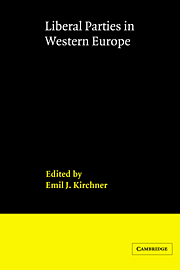Book contents
- Frontmatter
- Contents
- List of tables
- List of diagrams
- List of maps
- Notes on the contributors
- Preface
- 1 Introduction
- 2 Between left and right: the ambivalence of European liberalism
- 3 Two roads of Italian liberalism: the Partito Repubblicano Italiano (PRI) and the Partito Liberale Italiano (PLI)
- 4 The FDP in the Federal Republic of Germany: the requirements of survival and success
- 5 Great Britain — social liberalism reborn?
- 6 Liberalism in France
- 7 Liberal parties in the Netherlands
- 8 The Belgian liberal parties: economic radicals and social conservatives
- 9 The Freiheitliche Partei Österreichs: protest party or governing party?
- 10 The Swedish Liberal Party: The politics of unholy alliances
- 11 Liberalism in Denmark: agrarian, radical and still influential
- 12 The Norwegian Liberal Party: from political pioneer to political footnote
- 13 Liberal parties in Finland: from perennial coalition actors to an extra-parliamentary role
- 14 Liberal parties in Switzerland
- 15 The Luxemburg Liberal Party
- 16 Identifying liberal parties
- 17 Ambivalence revisited: an analysis of liberal party manifestos since 1945
- 18 Transnational links: the ELD and Liberal Party Group in the European Parliament
- 19 Western European liberal parties: developments since 1945 and prospects for the future
- Index of political parties
- General index
14 - Liberal parties in Switzerland
Published online by Cambridge University Press: 16 November 2009
- Frontmatter
- Contents
- List of tables
- List of diagrams
- List of maps
- Notes on the contributors
- Preface
- 1 Introduction
- 2 Between left and right: the ambivalence of European liberalism
- 3 Two roads of Italian liberalism: the Partito Repubblicano Italiano (PRI) and the Partito Liberale Italiano (PLI)
- 4 The FDP in the Federal Republic of Germany: the requirements of survival and success
- 5 Great Britain — social liberalism reborn?
- 6 Liberalism in France
- 7 Liberal parties in the Netherlands
- 8 The Belgian liberal parties: economic radicals and social conservatives
- 9 The Freiheitliche Partei Österreichs: protest party or governing party?
- 10 The Swedish Liberal Party: The politics of unholy alliances
- 11 Liberalism in Denmark: agrarian, radical and still influential
- 12 The Norwegian Liberal Party: from political pioneer to political footnote
- 13 Liberal parties in Finland: from perennial coalition actors to an extra-parliamentary role
- 14 Liberal parties in Switzerland
- 15 The Luxemburg Liberal Party
- 16 Identifying liberal parties
- 17 Ambivalence revisited: an analysis of liberal party manifestos since 1945
- 18 Transnational links: the ELD and Liberal Party Group in the European Parliament
- 19 Western European liberal parties: developments since 1945 and prospects for the future
- Index of political parties
- General index
Summary
To talk about parties belonging to liberalism in Switzerland is not an easy task. To the outsider the Swiss political system is quite a sophisticated one; so sophisticated that a political scientist following an approach based on economic rationality would give up the idea of studying such a country, since it is far too complicated given its political weight and influence in the world system.
As a federal country, Switzerland is divided into 26 states (cantons and half-cantons) with their own political culture, tradition, administration and party systems. The country is split into four languages and two religions; some cantons are bilingual and others are bi-denominational. Federal parties are rather vague and badly organised bodies, and the main parties are cantonal. Parliamentary parties and parliamentary groups do exist, but they are quite undisciplined. Even the social democrats are unable to achieve the political cohesion they show in other parliaments in the world. MPs do not sit either following the French hemicycle or the British ‘face to face’ opposition system. In the Senate – Conseil des Etats, Ständerat–they sit by cantonal delegation and in the House – Conseil national, Nationalrat – the MPs' desks are allocated according to a rather mysterious formula, combining language, party and canton, with decisions taken randomly. There is no majority rule, and the sole opposition is made up of small right-wing and left-wing parties – xenophobes, neo-fascists, communists and left socialists – even the ecologists accept the rules of amicable agreement. This means that the majority/opposition pattern varies depending on the issues involved. When an opposition party becomes electorally important, it receives a portfolio in either the federal or cantonal cabinets.
- Type
- Chapter
- Information
- Liberal Parties in Western Europe , pp. 359 - 375Publisher: Cambridge University PressPrint publication year: 1988



